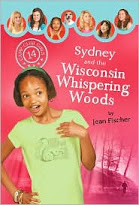You are being watched. Yes, the folks at Merriam-Webster.com are watching the words you look up on their website, and this month they listed the Top 10 Words of Summer 2010. Here they are.
 1. “Refudiate,” Sarah Palin’s combination of “refute” and “repudiate.” (You won’t find this one in the dictionary.)
1. “Refudiate,” Sarah Palin’s combination of “refute” and “repudiate.” (You won’t find this one in the dictionary.)2. “Inception,” most likely connected with the summer blockbuster movie with the same name.
3. “Despicable,” as in “Despicable Me,” another hit movie in Summer 2010.
4. “Moratorium.” Webster’s suggests this one is related to the Gulf oil spill.
5. “Austere,” probably a reflection of current global economic conditions.
6. “Cacophony,” looked up most often during the World Cup soccer match in South Africa and attributed to the use of the “vuvuzela.” (Look it up.)
7. “Doppelganger.” George Stephanopoulos, on "Good Morning America," sent viewers searching for this word. Do you think Julia Roberts and the real Elizabeth Gilbert look that similar?
8. “Opulent,” a popular word around the time of Chelsea Clinton’s wedding.
9. “Vapid.” Supreme Court nominee Elena Kagan used this word to describe her confirmation proceedings.
And finally, word number ten:
10: “Frugal,” relating to how Americans are adjusting to the current economic state.
If you haven’t visited the Merriam-Webster site lately, hop on over there and have some fun. Along with a searchable online dictionary and thesaurus, you’ll find dozens of fun word games and tons of information about new and interesting words.
******
What's In a Word?
Fascinating Stories of More Than 350 Everyday Words and Phrases
 If you love discovering the origins of words and phrases, check out this book by Webb Garrison. What's in a Word? is the sort of book that you can read in small bites. Filled with trivia, it is guaranteed to inspire out-of-the-ordinary dinner table conversation.
If you love discovering the origins of words and phrases, check out this book by Webb Garrison. What's in a Word? is the sort of book that you can read in small bites. Filled with trivia, it is guaranteed to inspire out-of-the-ordinary dinner table conversation.
Here’s a teaser: Do you know what it really means to “bring home the bacon?” This phrase originated in a 15th century entertainment venue similar to our modern-day reality shows. Way back in 1445, a church in Essex County, England began awarding a “flitch of bacon” to the pair of newlyweds who after one year of marriage was chosen as the perfect example of happiness and fidelity. A jury of six bachelors and maidens judged the contest, and the winning couple literally “brought home the bacon.”
What’s in a Word? is published by Thomas Nelson and available from your favorite bookstore.
Are you a member of Thomas Nelson’s Book Sneeze? Get free books in exchange for a review on your blog and any consumer retail website. Sign up here.
Disclosure of Material Connection: I received this book free from Thomas Nelson Publishers as part of their Book Review Blogger program. I was not required to write a positive review. The opinions I have expressed are my own. I am disclosing this in accordance with the Federal Trade Commission’s 16 CFR, Part 255: “Guides Concerning the Use of Endorsements and Testimonials in Advertising.”
Disclosure of Material Connection: I have not received any compensation for writing this post. I have no material connection to the brands, products, or services that I have mentioned. I am disclosing this in accordance with the Federal Trade Commission’s 16 CFR, Part 255: “Guides Concerning the Use of Endorsements and Testimonials in Advertising.”
Fascinating Stories of More Than 350 Everyday Words and Phrases
 If you love discovering the origins of words and phrases, check out this book by Webb Garrison. What's in a Word? is the sort of book that you can read in small bites. Filled with trivia, it is guaranteed to inspire out-of-the-ordinary dinner table conversation.
If you love discovering the origins of words and phrases, check out this book by Webb Garrison. What's in a Word? is the sort of book that you can read in small bites. Filled with trivia, it is guaranteed to inspire out-of-the-ordinary dinner table conversation. Here’s a teaser: Do you know what it really means to “bring home the bacon?” This phrase originated in a 15th century entertainment venue similar to our modern-day reality shows. Way back in 1445, a church in Essex County, England began awarding a “flitch of bacon” to the pair of newlyweds who after one year of marriage was chosen as the perfect example of happiness and fidelity. A jury of six bachelors and maidens judged the contest, and the winning couple literally “brought home the bacon.”
What’s in a Word? is published by Thomas Nelson and available from your favorite bookstore.
Are you a member of Thomas Nelson’s Book Sneeze? Get free books in exchange for a review on your blog and any consumer retail website. Sign up here.
Disclosure of Material Connection: I received this book free from Thomas Nelson Publishers as part of their Book Review Blogger program. I was not required to write a positive review. The opinions I have expressed are my own. I am disclosing this in accordance with the Federal Trade Commission’s 16 CFR, Part 255: “Guides Concerning the Use of Endorsements and Testimonials in Advertising.”
Disclosure of Material Connection: I have not received any compensation for writing this post. I have no material connection to the brands, products, or services that I have mentioned. I am disclosing this in accordance with the Federal Trade Commission’s 16 CFR, Part 255: “Guides Concerning the Use of Endorsements and Testimonials in Advertising.”















